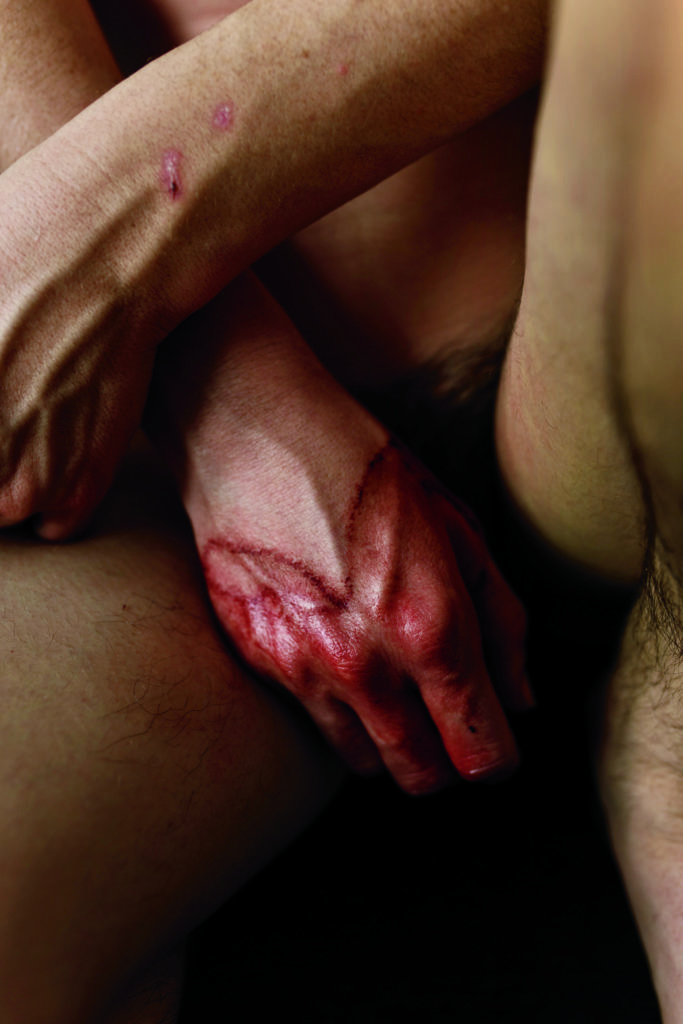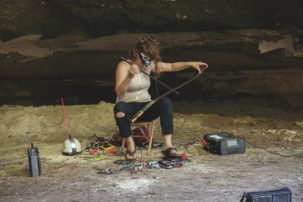Cum is more holy than God. God is omniscient; cum is dispersion. Cum is life even when it doesn’t contain sperm, even when it’s outside a body. This, I think, must be the message behind the tag that popped up on Brooklyn streets recently: GOD<CUM. Cum is divine and sacred; it is degraded and dirty. It is “seed,” not because it sometimes causes pregnancy but because it spells an arc toward life and proliferation. Cum is greater than God and family, or nation.
The predominant aesthetic of cum is the “money shot,” the flourish of most porn that features cis men and women or gay men, and signals the end of the sexual encounter. Predictably, according to the hierarchy of status symbols, the money shot usually shoots from a man’s penis. Not unlike fake blood on horror film sets, most of the cum we see in porn is fake. The eyes have been trained to need certain cues to make death, big or small, believable. In porn and horror, the murkily entwined genres of snuff and smut, the eye can become a cue itself: the widening eye of a slasher victim, the eye of a cock revealed in close-up. Is it conservative to propose a revelling in cum that is counter to the widespread availability of (free) money shots on the internet? I am not opposed to porn; I do not think it is evil, but free money is always a fraud for someone, and that someone is always the worker. My other qualm is not restricted to the porn industry but the entire regime of the visual. RIP the false promise of Smell- O-Vision and dildotectonics—the most thrilling part of cum is how it tastes, smells, drips, lingers, settles, dries, etc.
Cum exceeds the moment of ejaculation. It is the scent of somebody’s insides when you’re back outside. It is the cloth that is transubstantiated when designated as a cum rag. It is the stain. I was talking about cum with my co-conspirator, who in a typical blush of brilliance called cum a “sticky sociality.” It binds moments and people together, even fleetingly; it lets us know we did something. I invoked sticky sociality when writing about Samuel R. Delany’s smutty, post-apocalyptic novel Dhalgren. In a story with bizarre sky phenomena and holographic insects, the image I couldn’t shake was that of a street kid in the tangled bodies of an allnight orgy, his dick “slick with common juice.” A slight rephrase and it is the commons’ juice, an elixir made from the negotiation of multiple bodies sharing space—and sharing each other’s bodies, across multiple lines of difference.
Artworks, more than strictly textual works, can evoke and invoke this kind of commons. Art that takes sex as its specific interest makes acute this latent potential for arousal. Curiously enough, all the art of my small personal “cum works syllabus” described herein is produced from the muddled sites of Indigeneity and coloniality across the Americas, whether by Métis, Cree, Latinx or Chicanx artists. Thinking with the cum works, or thinking through an aesthetics of cum, allows a certain fluidity across borders, a consideration of the waters that pass between bodies and territories. In what follows, a lack of discretion becomes a lack of discreteness.
Two cum chronicles were recently shown in the travelling exhibition “Axis Mundo: Queer Networks in Chicano L.A.” at the Hunter College Art Galleries in New York. For his Journal of Sexual Activity (JSA): Field and Laboratory Notes, Gerardo Velázquez mimics a clinical technician’s jargon for medical test results, giving each “load” a sample number with a brief description of its “approximate composition” and “mode of acquisition.” In one entry the “load” was from a blonde surfer, collected (appropriately) from the “blue steel walls of a bathroom stall,” as well as from Velázquez’s own trousers. The toilet-paper square shown is only one of five, Velázquez notes with a parenthetical wink: “it was a big load.” The appropriation of the bureaucratic form belies the impersonal nature of the encounter, yet simultaneously the collected toilet paper reveals a closeness to the event, to the partner’s particularity. The “report” also pays attention to the public spaces that hookups can briefly transform. When did you last notice the walls of a bathroom stall? If it wasn’t because you were looking at a load, one hopes for some interesting scrawls. GOD<CUM, perhaps.
Velázquez’s predecessor Jerry Dreva goes the more playful route (hinging again on puns) with the bound collection 69 Wanks for the Memories: A Seminal Work/Book (1975), a copy of which resides in the National Gallery of Canada’s archives. Imagine flipping through the dusty pages of art history’s postmodern debates before fingering the volume of one man’s ejaculation diary. This was only one of many journals Dreva distributed to friends and other artists he admired, dreaming of proliferating his proliferations across a 20-volume series containing thousands of cum signatures.

 Elle Pérez, Dick, 2018. Archival pigment print, 1.12 m x 78.7 cm. Courtesy 47 Canal, New York.
Elle Pérez, Dick, 2018. Archival pigment print, 1.12 m x 78.7 cm. Courtesy 47 Canal, New York.







